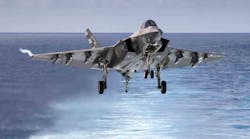The U.S. Dept. of Defense and Lockheed Martin Corp. have arrived at a new impasse over the F-35 Lightning II Joint Strike Fighter, as the Pentagon has stopped accepting most deliveries of new high-tech aircraft due to maintenance costs on more than 200 jets already in service with the U.S. Air Force, U.S. Marine Corps, and U.S. Navy.
The F-35 Lightning II is a single-engine aircraft fitted with Stealth technology and designed for deployment for ground attack and combat.
The Pentagon has not commented on the news, reported by Reuters and based on three sources familiar with the matter. A representative for Lockheed Martin, the lead contractor for the F-35 program, offered: “Production on the F-35 program continues and we are confident we will meet our delivery target of 91 aircraft for 2018. While all work in our factories remains active, the F-35 Joint Program Office has temporarily suspended accepting aircraft until we reach an agreement on a contractual issue and we expect this to be resolved soon.”
The F-35 program remains the basis of ongoing controversy due to the extraordinary high unit costs, which range from $94.6 million to $121.8 million, depending upon the jet model.
However, the present dispute concerns maintenance costs for the current fleet of 270 F-35 aircraft already deployed by the USAF, USMC, USN, and the defense forces of other nations. In testimony before the House Armed Services committee during February, a Defense Dept. official for the first time revealed that modernization costs to fix a production error on the jets will run to about $16 billion through 2024. That figure includes $10.8 billion for new software development and $5.4 billion to deploy the updates. Concerning the software development, $3.7 billion of the cost would be allocated to the other nations that participate in the F-35 program.
It is not known when DoD implemented the current halt to new deliveries.
Reuters also reported that in 2017 the Pentagon stopped accepting F-35s for one month after discovering corrosion to the airframes. Once a resolution was agreed, the deliveries resumed. Lockheed and its F-35 program partners (Northrop Grumman Corp, Pratt & Whitney, and BAE Systems plc, and others) are scheduled to deliver 90 new jets this year, building toward a peak production rate of 160 new jets per year by 2023.







